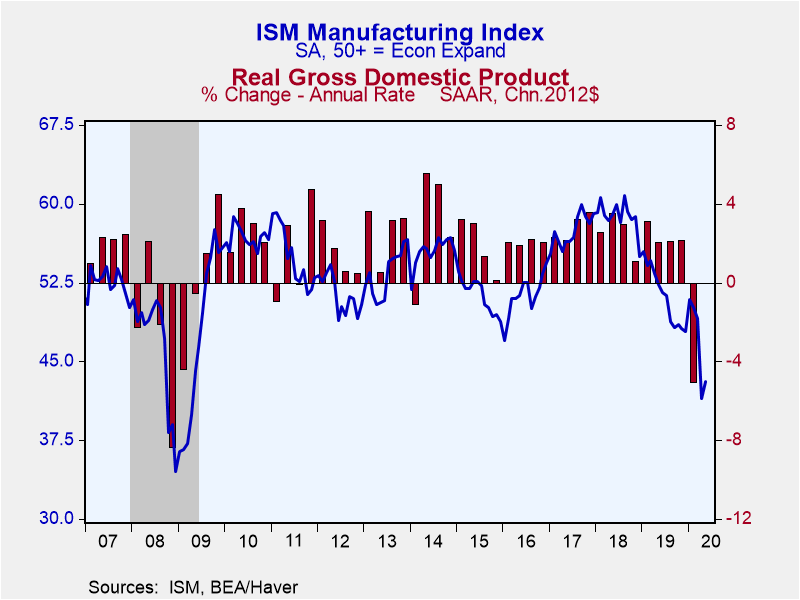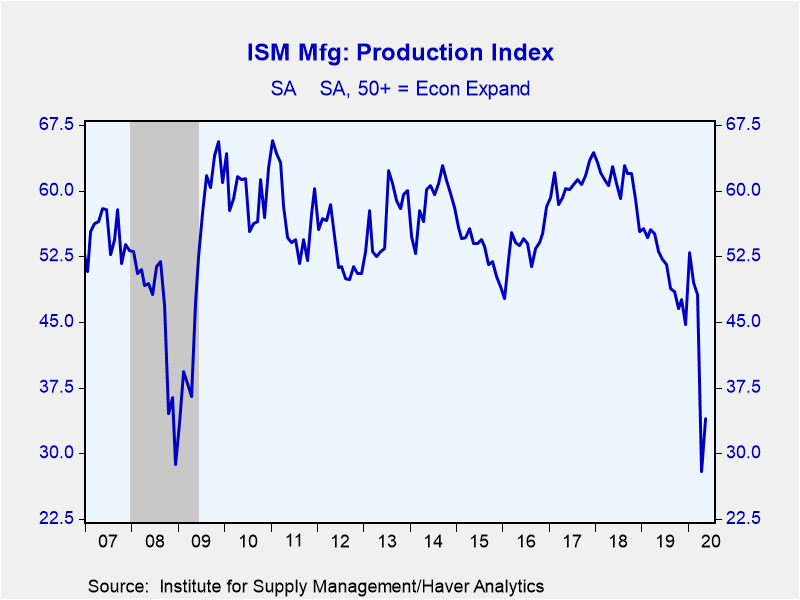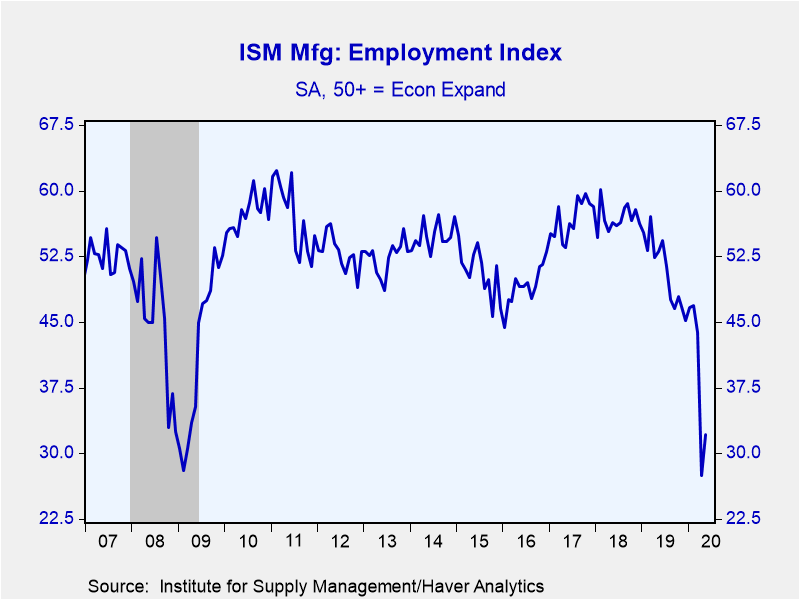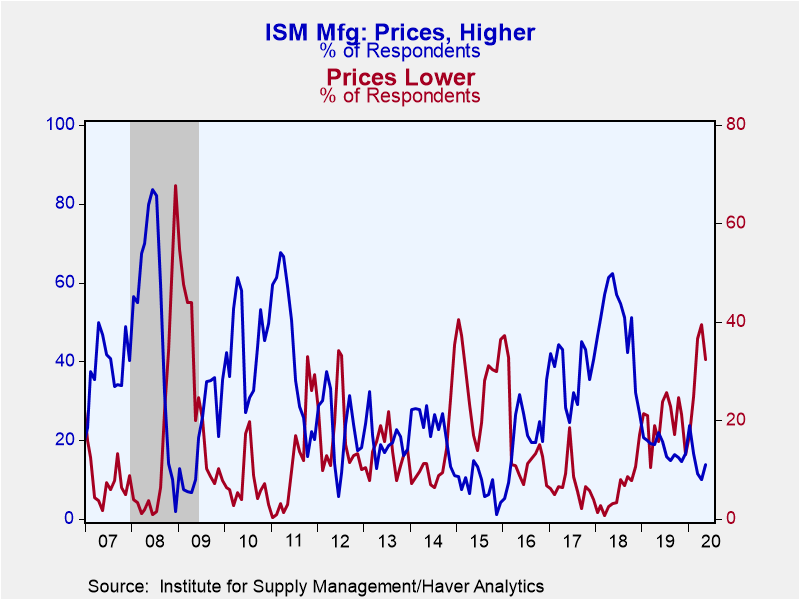 Global| Jun 01 2020
Global| Jun 01 2020ISM Manufacturing Index Improves in May
by:Tom Moeller
|in:Economy in Brief
Summary
• The Composite Index remained below the break-even level of 50 for the third straight month. • Monthly improvement in the component series was widespread. • The prices index rose moderately. The coronavirus exhibited less of a [...]
• The Composite Index remained below the break-even level of 50 for the third straight month.
• Monthly improvement in the component series was widespread.
• The prices index rose moderately.
The coronavirus exhibited less of a negative impact on factory sector activity in May, reported the Institute for Supply Management (ISM). The Composite index of manufacturing sector activity improved to 43.1 last month after declining to 41.5 in April, the lowest level since April 2009. A reading of 42.5 had been expected in the Action Economics Forecast Survey. During the last 15 years, there has been a 66% correlation between the composite index and the quarterly change in real GDP.
The production index increased to 33.2 from its record low of 27.5 in April. Despite the rise, only 20.7% (NSA) of respondents reported higher production while a lessened 51.5% reported a decline. The new orders index rose to 31.8, but recaptured just a piece of the April collapse to 27.1. It remained nearly the lowest level since December 2008. Twenty-one percent (NSA) of survey respondents reported higher new orders while 53% reported lower orders.
Adding to the improvement was a rise in the employment measure to 32.1 after collapsing to 27.5 in April. Just eight percent (NSA) of respondents reported higher payrolls while 41% reported declines. Before the April decline, there was a 68% correlation between the employment index and the m/m change in factory sector payrolls.
The supplier delivery measure decreased to 68.0 from 76.0, indicating a somewhat lessened number of bottlenecks in the supply chain. The inventories measure rose slightly to 50.4, but remained below the recent peak of 53.9 in August 2018.
The prices paid index rebounded to 40.8 (NSA) after weakening in the prior two months. A still-depressed 14% of respondents reported higher prices while 32% reported declines.
Other series in the ISM report indicated weakness. The export order measure only improved to 39.5 after weakening to 35.3, the lowest level since late-2008, down from a high of 62.8 in February 2018. The import series remained near its expansion low while the order backlog measure also held steady after plummeting in April.
The ISM figures are based on responses from over 400 manufacturing purchasing executives from 20 industries, which correspond to their contribution to GDP in 50 states. The ISM figures are diffusion indexes where a reading above 50 indicates expansion. The figures from the Institute for Supply Management can be found in Haver's USECON database; further detail is found in the SURVEYS database. The expectations number is available in Haver's AS1REPNA database.
Market Assessment of COVID-19 from the Federal Reserve Bank of San Francisco is available here.
| ISM Mfg (SA) | May | Apr | Mar | May'19 | 2019 | 2018 | 2017 |
|---|---|---|---|---|---|---|---|
| Composite Index | 43.1 | 41.5 | 49.1 | 52.3 | 51.2 | 58.9 | 57.4 |
| New Orders | 31.8 | 27.1 | 42.2 | 52.5 | 51.1 | 61.6 | 62.1 |
| Production | 33.2 | 27.5 | 47.7 | 52.0 | 51.2 | 60.9 | 60.9 |
| Employment | 32.1 | 27.5 | 43.8 | 53.1 | 50.9 | 56.9 | 56.8 |
| Supplier Deliveries | 68.0 | 76.0 | 65.0 | 52.5 | 52.9 | 62.0 | 56.8 |
| Inventories | 50.4 | 49.7 | 46.9 | 51.4 | 49.8 | 52.9 | 50.4 |
| Prices Paid Index (NSA) | 40.8 | 35.3 | 37.4 | 53.2 | 49.1 | 71.7 | 65.0 |
Tom Moeller
AuthorMore in Author Profile »Prior to joining Haver Analytics in 2000, Mr. Moeller worked as the Economist at Chancellor Capital Management from 1985 to 1999. There, he developed comprehensive economic forecasts and interpreted economic data for equity and fixed income portfolio managers. Also at Chancellor, Mr. Moeller worked as an equity analyst and was responsible for researching and rating companies in the economically sensitive automobile and housing industries for investment in Chancellor’s equity portfolio. Prior to joining Chancellor, Mr. Moeller was an Economist at Citibank from 1979 to 1984. He also analyzed pricing behavior in the metals industry for the Council on Wage and Price Stability in Washington, D.C. In 1999, Mr. Moeller received the award for most accurate forecast from the Forecasters' Club of New York. From 1990 to 1992 he was President of the New York Association for Business Economists. Mr. Moeller earned an M.B.A. in Finance from Fordham University, where he graduated in 1987. He holds a Bachelor of Arts in Economics from George Washington University.










